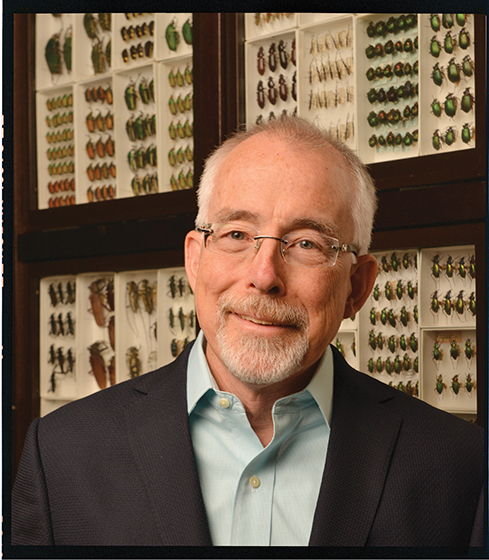 Fall 2015
Fall 2015|
Steve Tonsor
Steve Tonsor is a man on a mission. “It’s crucially important that we put that creative part, that joyful part back into science,” he says. “It’s important for future funding, for credibility, and mostly for our ability to communicate to the public what they need to know to make sound decisions.” As Carnegie Museum of Natural History’s director of science and research, he’s getting the chance to do exactly that, and he couldn’t be happier. Tonsor came to the museum last November after decades spent conducting and overseeing research—out in the field and, most recently, in The Tonsor Lab at the University of Pittsburgh, where he was associate professor of biological sciences. There he led up to 20 scientists in studying the biodiversity in plants and their adaptations to changes in climate and environment. Years before, he had earned his doctorate in evolutionary and quantitative genetics and population genetics at the University of Chicago before serving on the faculty at Michigan State’s W.K. Kellogg Biological Station. At one time Tonsor was also a National Science Foundation (NSF) program officer, and he continues to serve on NSF review panels today. But it was about six years ago when Tonsor broke with convention and invited Pittsburgh artist Natalie Settles to set up shop in his lab, where she collaborated with his team to create “evolving wallpaper”—projections that change patterns over time in response to interactions with viewers. “I wanted to put art and creative activities back into my life and back into my scientific life,” Tonsor says. After all, he adds, it’s what comes before the rationality of science that really fuels creativity of all kinds—“that inspiration that is the beginning of a poem, or a piece of music, or a piece of science.” What excited you most about taking this position?It takes me into a new phase in my research career. I’m not running a plant-evolution lab with 15 or 20 people in it anymore. Instead, I’m leading a group of about 50 scientific staff in a broad array of questions, and I love that. There’s a real joy and thrill in it. So my job here is to be somewhat involved in many kinds of research rather than intensely involved in a particular kind of research. What’s the biggest difference between museum and university science?The museum is partly about the dissemination of its discoveries to the scientific community. But it is at least as much about reaching all of our communities and making that knowledge accessible in a way that people can make use of it. Some of that use is economic, and some of it is, in a sense, spiritual—it’s about understanding the nature of existence, our place in the world, and what that means. How do you think the public views scientists?What we’ve often done is separate ourselves from the public and create the sense that science is something that ordinary people can’t do and can’t understand. There’s a kind of deference to scientists, but it’s not a friendly deference. We’ve also portrayed science as a kind of coldly rational process. Rationality is important. But when I think back to what led me to be a scientist, it wasn't cold rationality that did it; it was the kind of revelatory feeling I had in seeing the world around me. And loving life, and wanting to know more about it. In what ways can art play a role in science?Despite the importance of creative methods to science, we don’t train scientists in those ways. We have superb training in genomics, use of atomic force microscopes, and crazily complex things, but nothing about how to think creatively. So that’s why I invited Natalie [Settles] to put her studio in the middle of my lab. And that was a really fruitful thing. It’s hard for me to measure in my students how much of an effect that had, but I can see in my own ways of thinking and approaching my work how it affected me, and I think I’m a better scientist as a result of it. Do you see it as your role to challenge the museum’s scientists to think more creatively?Absolutely. The museum is an incredible place to do scientific work, and it’s a tremendous privilege to be in a curatorial position here. Along with that privilege comes a great responsibility to really do something important. And it’s not just a role of primary scientific discovery—it’s a role of discovery and dissemination of information. What are some of today’s big scientific questions?For this museum, they are questions of understanding the tree of life—the evolutionary processes that lead to the diversity of organisms on the earth—and the web of life— the way that the diversity of organisms interacts with each other. Those two things are tightly intertwined. Many of the species on the earth today are there because they live in the context of other species—insects that feed on the tree out the window, birds that eat those insects. And these important questions in science are generally not questions that an individual researcher can address. They really require a number of kinds of expertise working as a team. Is that what you’re doing here at the museum?Yes. We have to work together. We have to be able to show that what we do is valuable—to Pittsburgh and the broader world. We have to continue to have a set of curators who are absolutely world-class and doing important research. And we have to be able to communicate it to the world.
|
Book Smart · Imperfectly Modern · Divine Provenance · The Fab (Lab) Life · President's Note · NewsWorthy · Artistic License: Drawing Hopper · About Town: Move Over, T. rex · First Person · Travel Log · The Big Picture
 |
Copyright © 2017 CARNEGIE Magazine. All rights reserved. |

